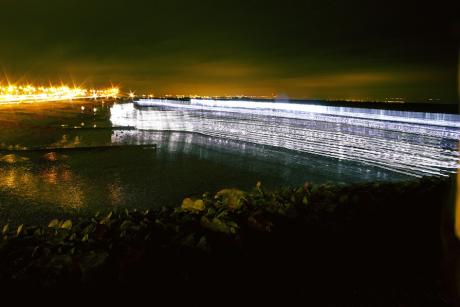What the Tide Told Us

Unique Digital and Syzygy devised a world-first cross-media art installation as their contribution to the "Duchamp in Herne Bay" festival. An homage to the master of reappropriation, "Human Tide" aimed to extend the influence of Marcel Duchamp into the data-rich 21st century. Whilst not exactly the relaxing visit to the Kentish seaside he'd imagined, Matthew Sykes found much to love about the experience.
On the pebble laced beach of Herne Bay, a gaggle of weathered travellers pace the sodden sand. Those blessed with foresight wear wellies and thick jumpers, while the rest (the “intrepid”, if you’re in a kind mood) brave the wind and wet in running shoes and anoraks.
They walk two abreast, each pair carrying between them a metre tall torch and a mobile phone. Their aim is to trace in light and recorded GPS-data the recession and advancing of the tempestuous tideline, a feat staged in homage to the late great Marcel Duchamp.
It was a difficult brief to meet: as part of “Duchamp in Herne Bay” (a 17 day festival commemorating the 100th anniversary of the avant-gardist’s time in Kent) Unique Digital and Syzygy were tasked with emulating and updating Duchamp’s polyvalent legacy.
What they dreamt up in response was a visually stirring and conceptually provocative premise: a 3D mirror rig camera capable of capturing long exposure and time lapse photographs simultaneously, mounted atop 16-feet or so of scaffolding, would record the light trail of 30 torchbearers walking in step with the tide. As a stunt it would represent both a logistical nightmare and a world first – a fitting tribute to the ever innovative and defiant Duchamp.
It was in admiration of the project’s scope that I joined the Human Tide team for the walk down Herne Bay. Bringing with me only a basic understanding of the group’s objectivities, I had hoped to gather a more complete perspective on the meaning of the piece (pitched as an update of Duchamp's "Three Standard Stoppages") over the night. What I discovered, though, was a work of rhizomatic proportions: a network of artworks occurring across a range of media, with each separate gesture speaking to a different aspect of “Human Tide”. There was no way I could pin it down, no chance of me eking out an easy interpretation.
Not only is there the long-exposure/time-lapse photograph series (scheduled for exhibition in September), but there’s also a forthcoming audio interpretation (the raw recording of which you’ll be able to remix yourself via the Human Tide Soundcloud), and a release of all captured images and GPS data. A properly open-ended and collaborative project, then, and one which will only properly begin to take shape in the coming months.
While the experience oscillated between spells of gallows humour (what else to do when the ocean begins to race back toward the shore and you’re 100 metres down the beach?) and snatches of quiet introspection, the dominant mood amongst participants was one of bubbling anticipation. It’s for this reason that the long exposure photograph captured by the camera serves ultimately as a uniting metaphor for the whole project: Human Tide 2013 will be an artwork intelligible only when viewed in its entirety.
Data-Dada? Arguably.
Technological sublime? We’ll see.
Duchamp for the 21st century? No doubt.

